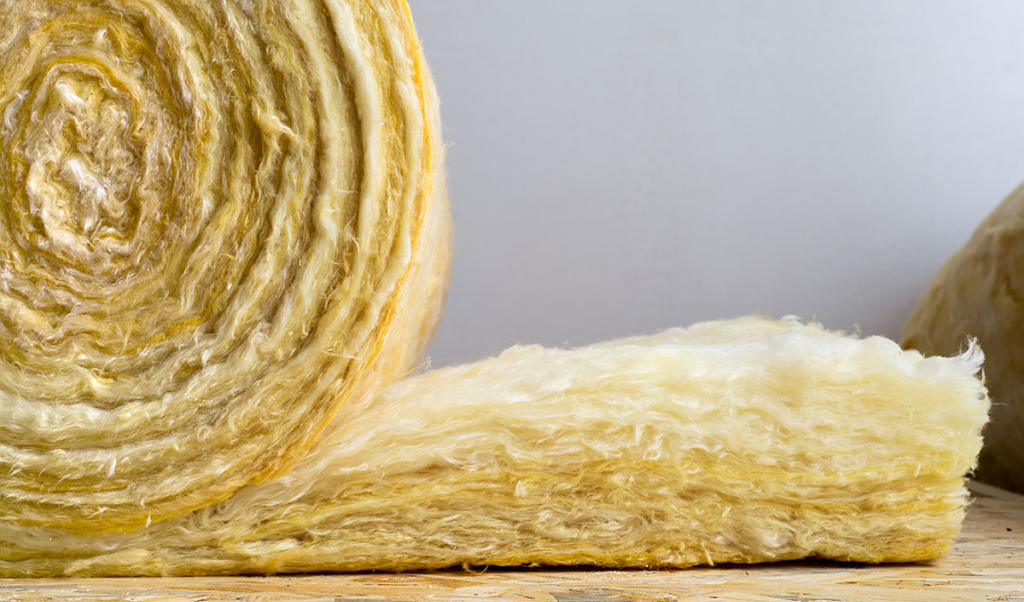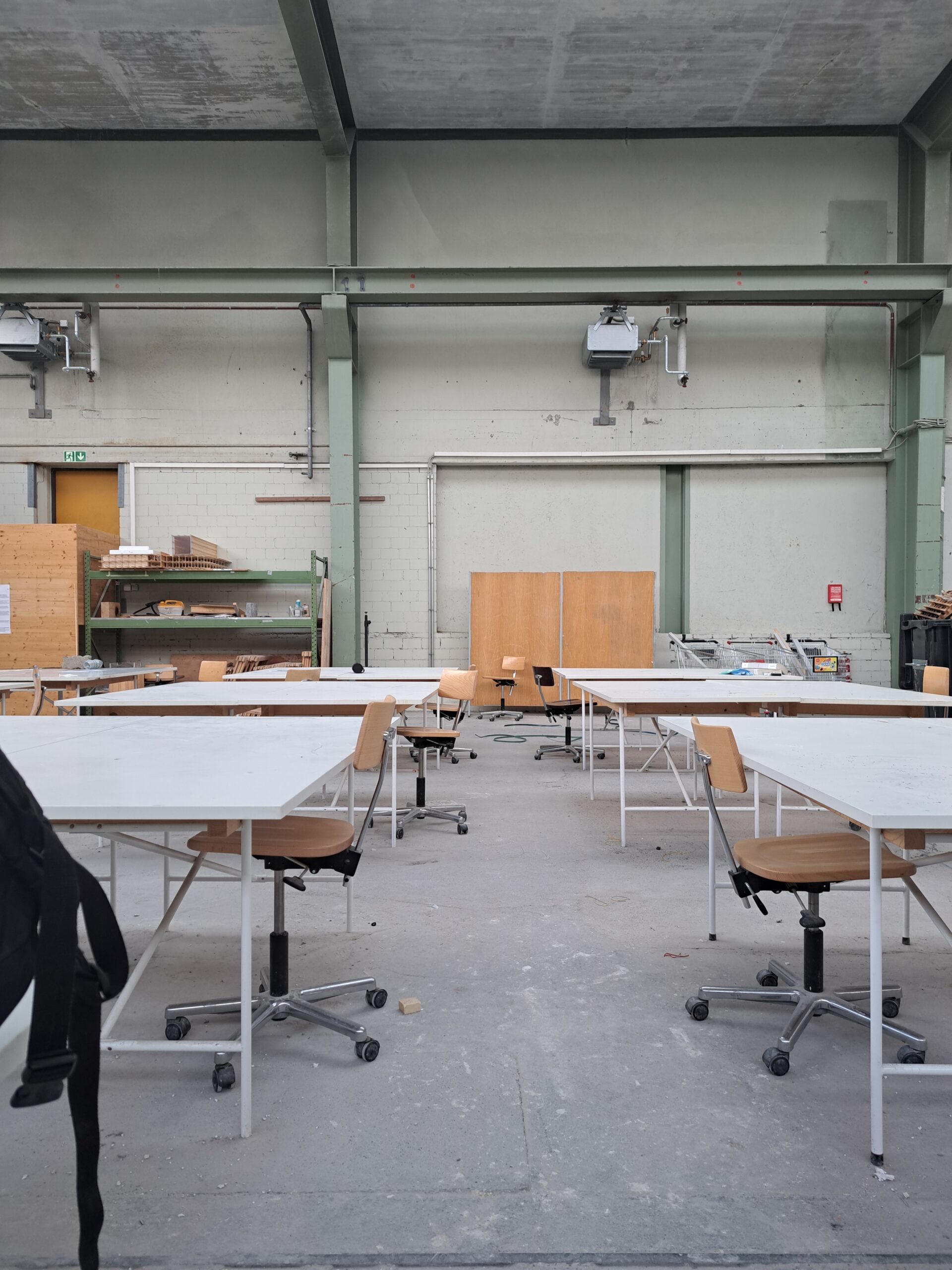Noel Manetti
1st space – inside: RIA Atelier, Oerlikon

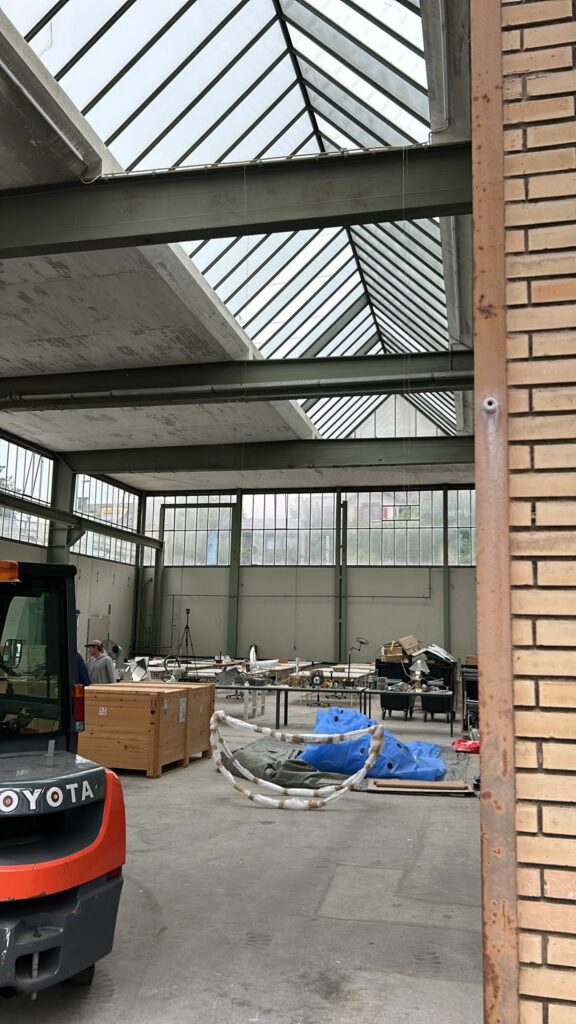
RIA is a “Stattwerk,” an industrial workshop transformed into a studio for the architecture department of ETH Zurich. Working for hours in such a space makes it impossible to ignore the room’s acoustics. In fact, the sound can quickly become chaotic and irritating due to poor acoustic control. It’s difficult to understand people that are speaking close to you. The surfaces, primarily made of concrete and glass, reflect noise, amplifying it throughout the space.
Compounding the issue is the fact that the room typically accommodates around 30 people simultaneously, either conversing or using tools. Consequently, sounds are amplified by the room, creating a thunderous effect. It is often challenging to understand conversations with those nearby due to the overwhelming noise.
Acoustic comfort can be improved by opening the large roll-up door, which allows noise to escape rather than reverberate within the space.
Reverberating-booming-cavernous-expansive-Echoing-(Rimbombante)
2nd space – outside: Spielplatz im Birch, Oerlikon
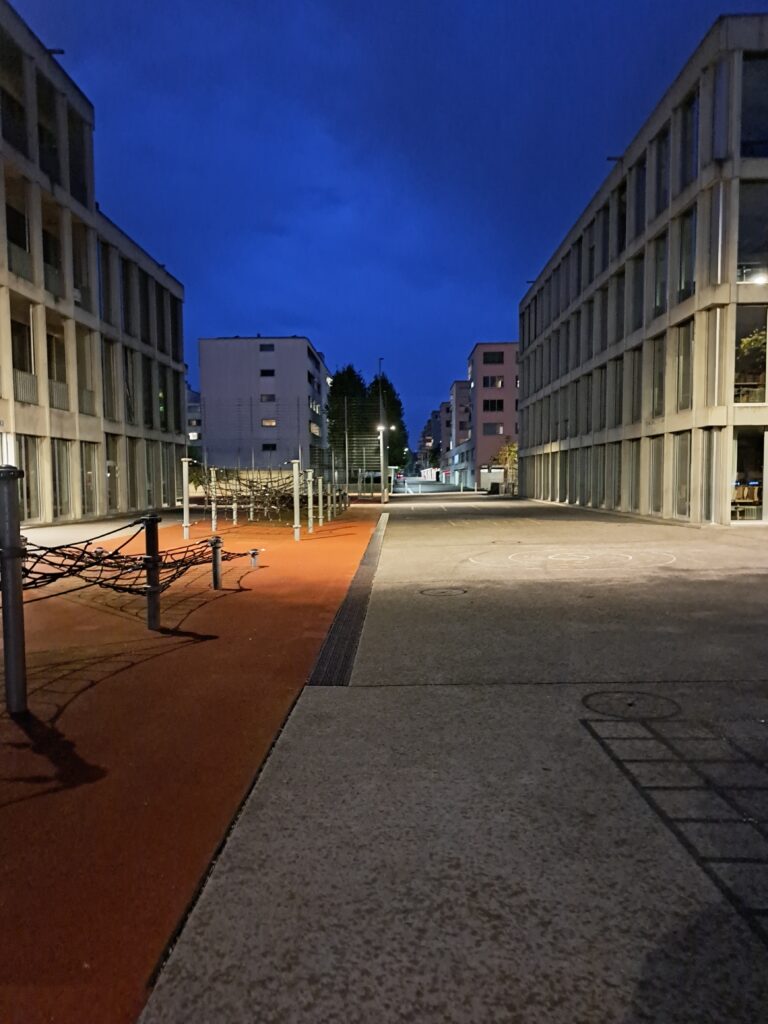


The exterior courtyard of this location presents an intriguing acoustic environment. Sounds are reflected by the surrounding block buildings, while the glass/concrete walls as well as the asphalt flooring amplify the noise. Unlike enclosed spaces, where sound is trapped and echoed, here the noise can spread freely into the air. Voices and distant shouts are also accentuated in this open area. During certain times of the day, the courtyard can become quite loud, especially with the presence of many children and pedestrians passing through.
The acoustic of the space reminds of the acoustic of an amphitheatre where noises and voices expecially from far distances are still well recognizable.
Resonant-Amplified-Clear-Echoing
2 Exploring the Emotional Impact of Everyday Sounds
Church Park
The acoustic environment of a park near a church is a serene and harmonious blend of sounds. The gentle ringing of the church bells echoes through the air, creating a tone that resonates across the open space. In the meantime it’s possible the soft sound of birds singing in the trees. The park feel like a tranquil oasis inside the city of Zurich.
1:11 Ring bell
0:07: workers hammering
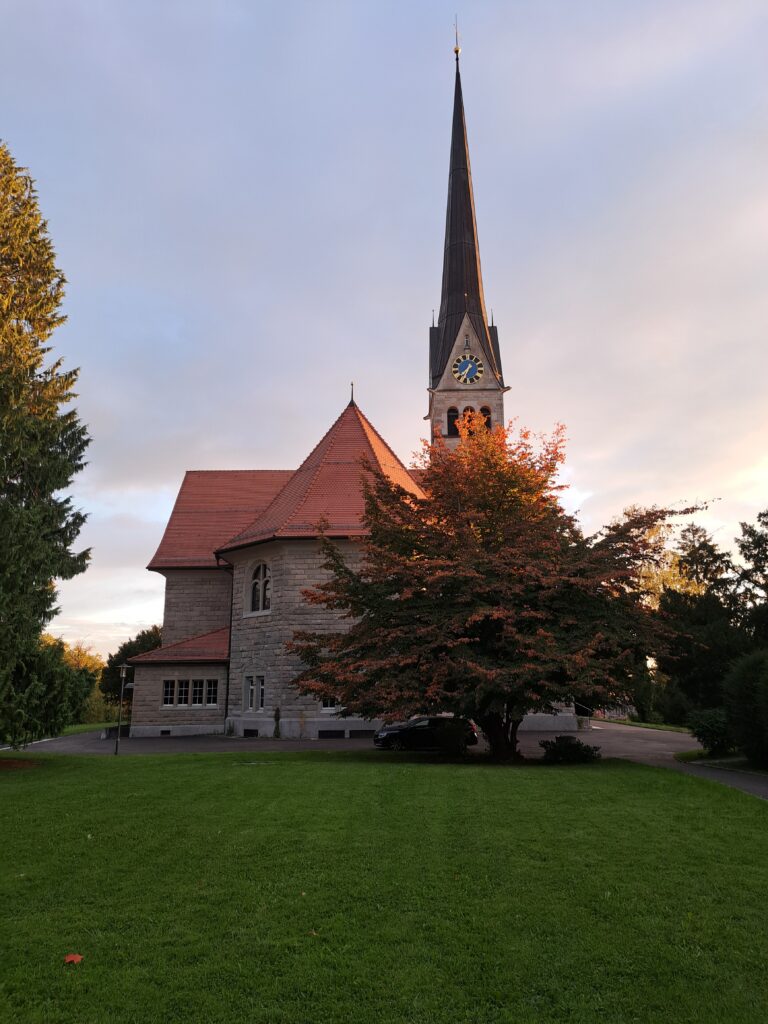
Birds singing: calming but can be a distractive sound. They are unexpected but soft sings. Mainly high-pitched, melodic tones that vary in frequency and intensity. Depending on the environment, the birds’ calls may either reverberate softly or blend into the background. They normally sing more in the moring.
Bell ring: defenitely the most emerging sound that personally makes me fell relaxed and like at home. It’s not that melodic but more ryhtmatic and ripetitive. It’s a recurring sound that during the may makes me have a conception of the time that is passing. Firsts notes of the motif have a high frequency while in the last part they have low frequency. Very “metallic” and resonating sound with volume sound. It is possible to be heard from far distaces.
Workers in the distace: Unexpected and distracting sound reverberating.
Airplains: The acoustics of an airplane’s reverberation in the sky create a distant, rumbling effect. As the sound travels across the open air, it becomes diffuse and expansive, spreading out and softening as it reaches the listenervery low frequency sound.
Oerlikon train station


2:39: bus driver laugh
2:22: train approaching
The acoustic environment of the Oerlikon’s train station is a layered blend of sounds. We can hear people chatting, laughing and murmuring. The voices of people standing under the bus stop’s canopy are considerably amblified by the effect of the reflection on the concrete roof . The main covering and predominant noise is the train as it gets closer, the sound becomes a metallic clattering of wheels on tracks. . Both the platform’s canopy and the bus stop’s canopy are made in metal or concrete. For this reason there is no sound absorption.
train noise: It’s definitely a irritating and harsh noise, expecially considering that this noise is amplified and reflected by the canopy itself.
cars: They are more a background noise and doesen’t predominate on other ones that are closer and amplified.
laughs: the more predominant noises, they come unexpectedly and can often be irritatin or on the other side they can be funny.
Empirical and numerical estimation of
room acoustic properties
For this exercise I went back to the acoustic of the RIA atelier studio in Oerlikon to investigate more the reverberation qualities and disadvantages of the room.
Clapping
1)
RT60= (4,65 s – 3,7 s)*2 = 1,9s

2)
RT60= (7,5 s – 4,1 s) = 3,4 s

Hammer (20 m distance from the recorder)

RT60= (6,2 s – 3,5 s)*2 = 5,4 s
4 Characterization of room acoustic treatments
There is no type of acoustic control present, as all surfaces are made of sound-reflective materials such as concrete, steel, bricks, or glass. These materials may be highly reflective across a wide range of frequencies, but they tend to reflect high and mid frequencies more effectively, contributing to reverberation in these ranges. This can be perceived as a strong echo, particularly with high-pitched sounds. The only thing present in the room that could absorb noise are the people. The workshop features a sloped skylight running the entire length of the ceiling. I assume that this element plays an important role in further sound reflection.
To enhance the space’s acoustic performance, curtains could be installed around the glazed walls, providing both sound absorption and protection. Additionally, the considerable height of the room offers an opportunity to suspend absorbers within the space. These could be designed in various geometries, as their shapes and orientations would influence how they interact with and redirect reflected sound waves.
5. The full picture
Considering a reverberation time of 3,4 s and esimating the volume of the space around 5400 m3 (16m * 28m *12m)

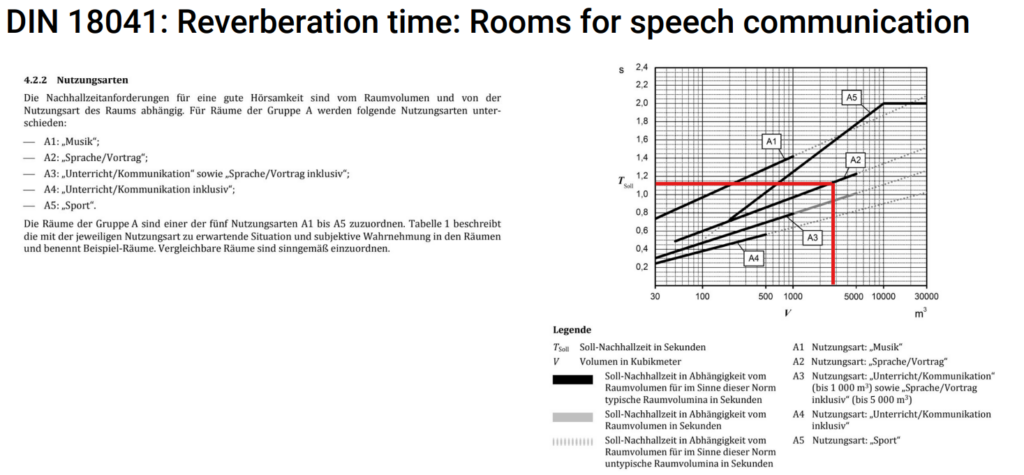

The current reverberation time is not suitable for a student workspace designed to accommodate 60 people at once. Acoustic treatment interventions would be necessary to meet educational standards and ensure a more functional environment. For this reason, ETH mandates the use of acoustic protection in cases where activities like hammering take place in the room.
We shlould take in consideration that the space in question was originally designed as a workshop for industrial production and later converted into an educational environment where presentations and discussions take place. However, this functional conversion was not accompanied by an assessment of the space’s acoustic quality. Workshops and production areas typically adhere to less stringent acoustic standards compared to educational and workshop environments, as speech intelligibility and acoustic comfort are not usually a priority in such operational spaces.
Metallic bar hitting the ground
The sound of a metallic bar hitting the ground is a characteristic yet highly disruptive noise in the RIA space. This often occurs accidentally when people handling metallic tools or materials drop them by mistake. The resulting sound, dominated by high frequencies, is amplified and reflected throughout the space by the concrete surfaces, which are more reflective of high frequencies than low ones.
Final assignment
DESCRIPTION
RIA is a “Stattwerk,” an industrial workshop transformed into a design studio for the architecture department of ETH Zurich. It consists of a single large open space measuring 16m x 20m x 12m, constructed with concrete, brick, glass, and metal. The space is intended to serve as a working environment for producing models using different materials and techniques. It also functions as a venue for large presentations and smaller discussions. The open layout is used by two different design studios at the same time and on the same days, which means that noisy model production can occur simultaneously with big presentations involving guests and various smaller discussions. During atelier days, the space can accommodate up to 60 people. The room is divided into two halves, with one half primarily used by Atelier Holtrop as a workspace featuring tables for model production and computer work, and the other half dedicated to presentations and discussions, with wooden panels in place. Certain corners are set aside as relaxation areas where students can take breaks, drink coffee, or have a snack. The building lacks both toilets and a heating system.
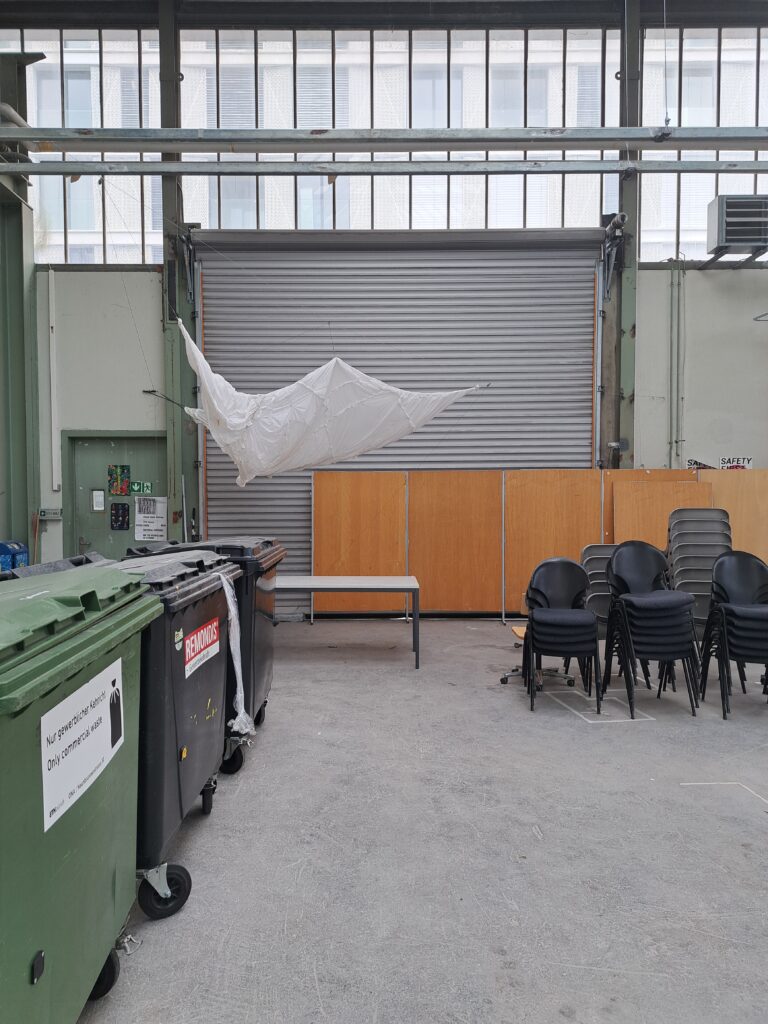


CRITICALITIES
The transformation of this industrial factory into an educational environment where presentations and discussions take place did not include an assessment of the space’s acoustic quality. Educational and presentation spaces typically require adherence to more stringent acoustic standards compared to industrial workshops. In this case, the reverberation time of 3-4 seconds is far too high for an educational setting. This is particularly problematic given the variety of functions that often occur simultaneously and generate very high noise levels. For this reason, the Department of Architecture advises the use of hearing protection during activities such as hammering.



Reverberating-booming-cavernous-expansive-Echoing-(Rimbombante)
The acoustics of the space are characterized by a reverberating, booming, cavernous, and echoing nature that makes prolonged work within the environment difficult to endure. The sound often becomes chaotic, irritating, and incomprehensible due to the lack of effective acoustic control. Conversations with nearby individuals can become challenging to follow because of overwhelming noise and voice dispersion. The surfaces of the room, primarily made of concrete and glass, reflect sound, amplifying it and increasing reverberation. There are no sound-absorbing materials or elements present in the space other than the bodies of people, which provide minimal absorption. The only way to improve acoustic comfort is by opening the large roll-up door, which allows noise to escape rather than reverberating inside.

RT60= (4,65 s – 3,7 s)*2 = 1,9s
The absence of acoustic control in the room is evident, as all surfaces are made of reflective materials such as concrete, steel, brick, and glass. These materials reflect sound across a wide range of frequencies but are especially reflective in the high and mid-frequency ranges, which leads to a pronounced echo, particularly with high-pitched sounds. The sloped skylight running the length of the ceiling likely contributes further to sound reflection. The current reverberation time makes the room unsuitable for a student workspace designed to accommodate 60 people. Acoustic treatments are essential to align the space with educational standards and to ensure it is functional for its intended purposes. The ETH Architecture Department has mandated the use of hearing protection for specific activities like hammering, highlighting the inadequacy of the current acoustic environment.
The sound of a metallic bar hitting the ground is a particularly disruptive noise in the RIA space. This sound, often resulting from accidental drops of metallic tools or materials, is dominated by high frequencies that are amplified and reflected throughout the space by the concrete surfaces, which are more reflective of high frequencies than low ones. Introducing elements such as curtains around the glazed walls would help to absorb sound and offer additional protection. The considerable height of the room also provides an opportunity to suspend absorbers within the space. These absorbers could be designed in various geometries, as their shapes and orientations would affect how they interact with and redirect reflected sound waves.
First phase – Geometry tests
The exercise consists in placing different types of blocks that can host dedicated divided spaces such as break room, toilets and quiet spaces for individual discussions.
0. CURRENT SCENARIO
The simulation is meant to riproduce the scenario where a person in the working area acts as a source of noise that is propagated through the whole room.
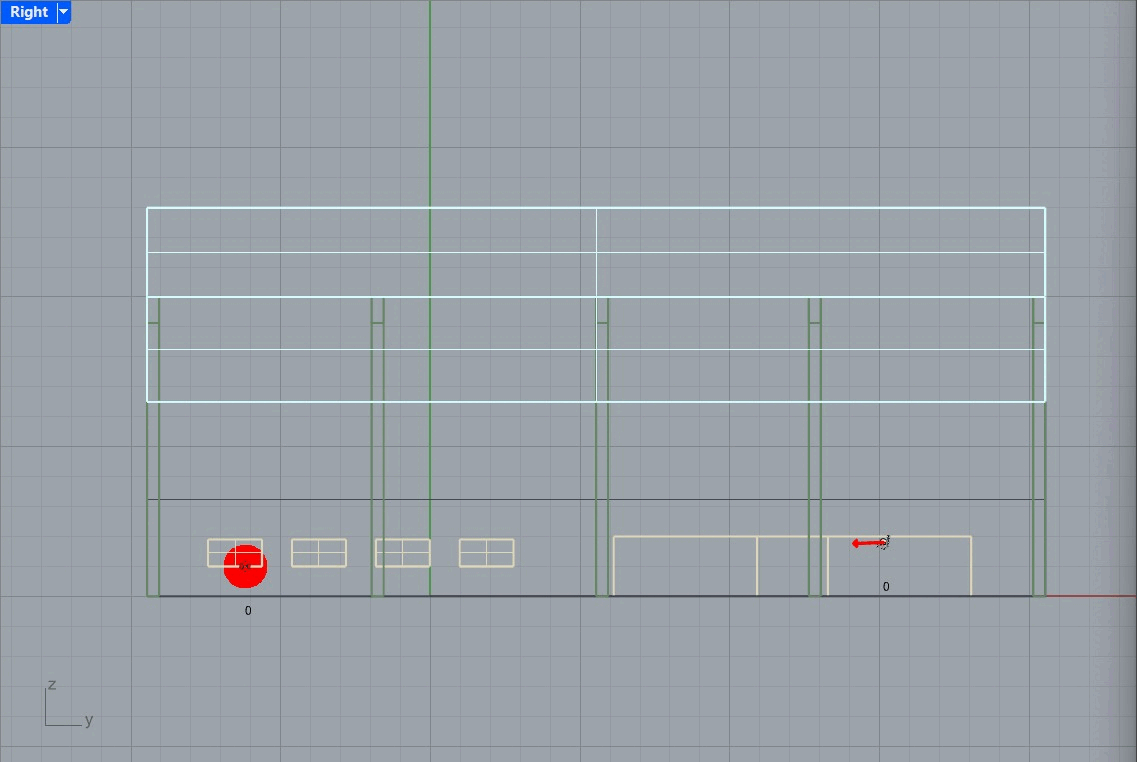
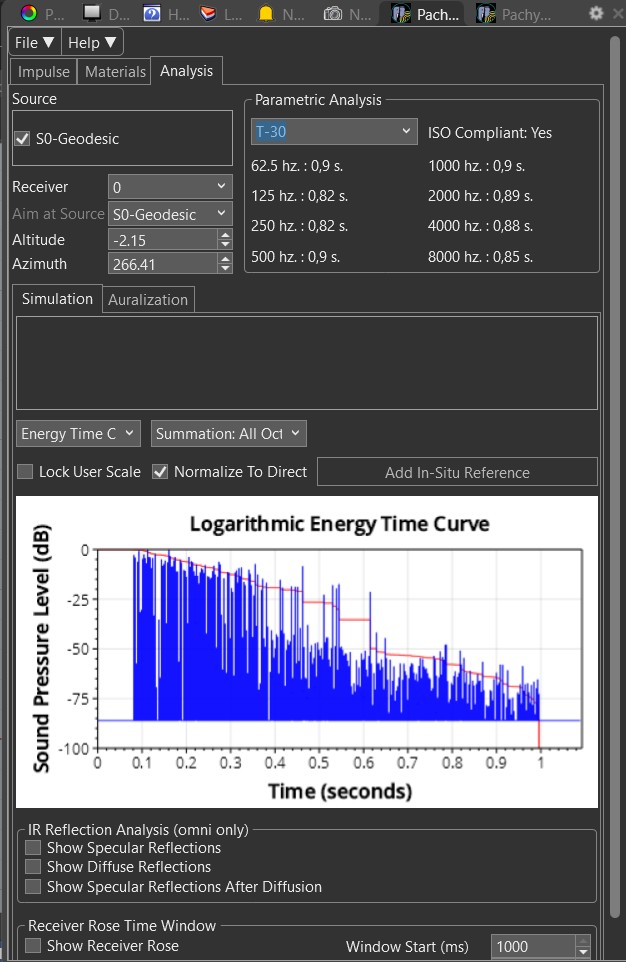

The simulation confirms a reverberation time (T60) of approximately 2 seconds (calculated as T30 x 2 = 0.9 x 2 = 1.8 s). From the animation, we observe that sound particles take a significant amount of time to travel through the entire room and reach the receiver. This delay increases notably in scenarios where the particles return to the source, such as when a person listens to another person’s voice directly in front of them.
In this case, some particles will travel straight to the listener’s ear, constituting the direct sound, while many others will traverse the room, bounce off the opposite wall, and eventually return. These delayed particles will be perceived as reverberation.
A clarity (C50) value lower than -3 dB indicates that speech is highly unintelligible, as the reverberation overwhelms the direct sound, making it difficult to discern speech clearly. We now make tests with different possibilities of inserting a service block into the room.
1.FILLED CORNERS
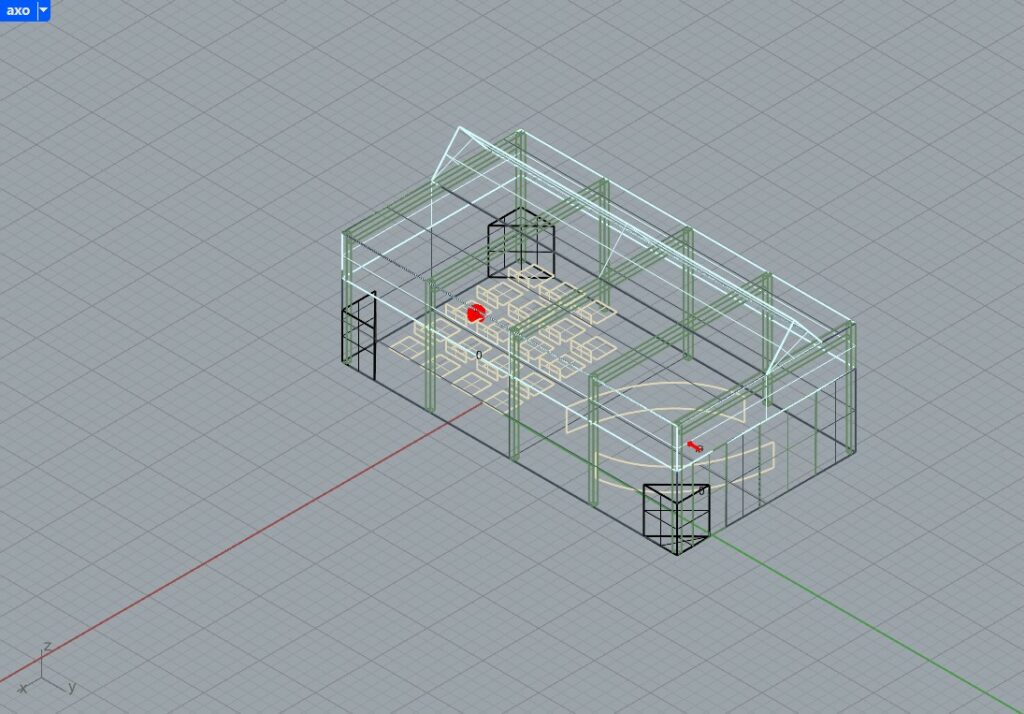

Although this may appear to be a way to introduce service blocks without compromising the flexibility of the space, as they occupy only the corners in a subtle manner, this intervention actually worsens the situation, as the reverberation time increases.
2. ROUND BLOCK IN BETWEEN
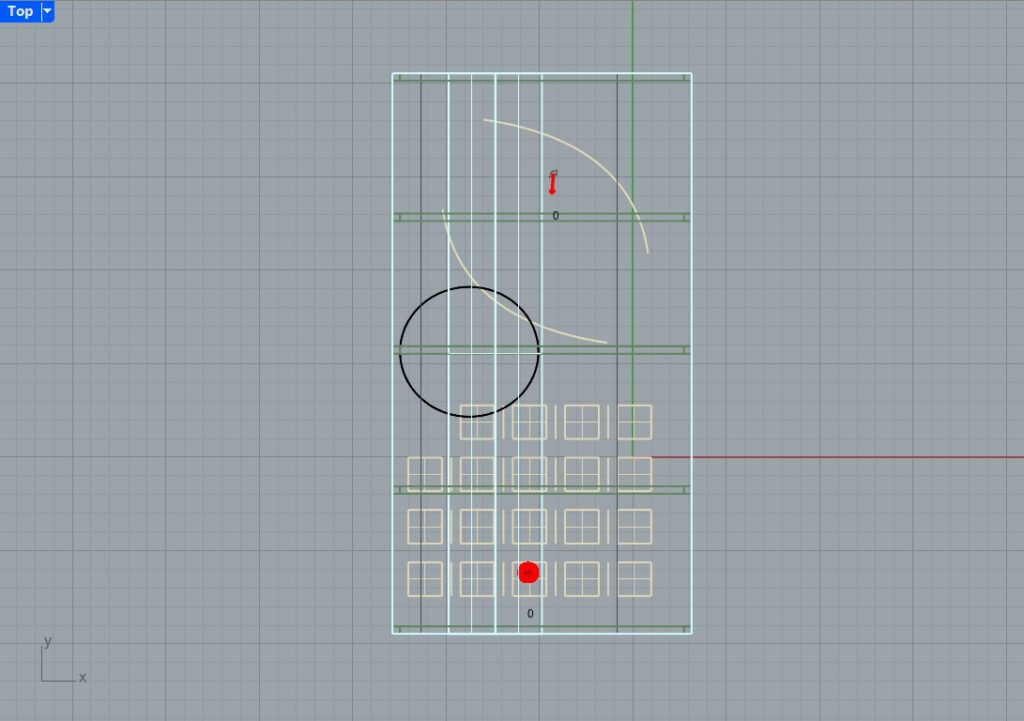
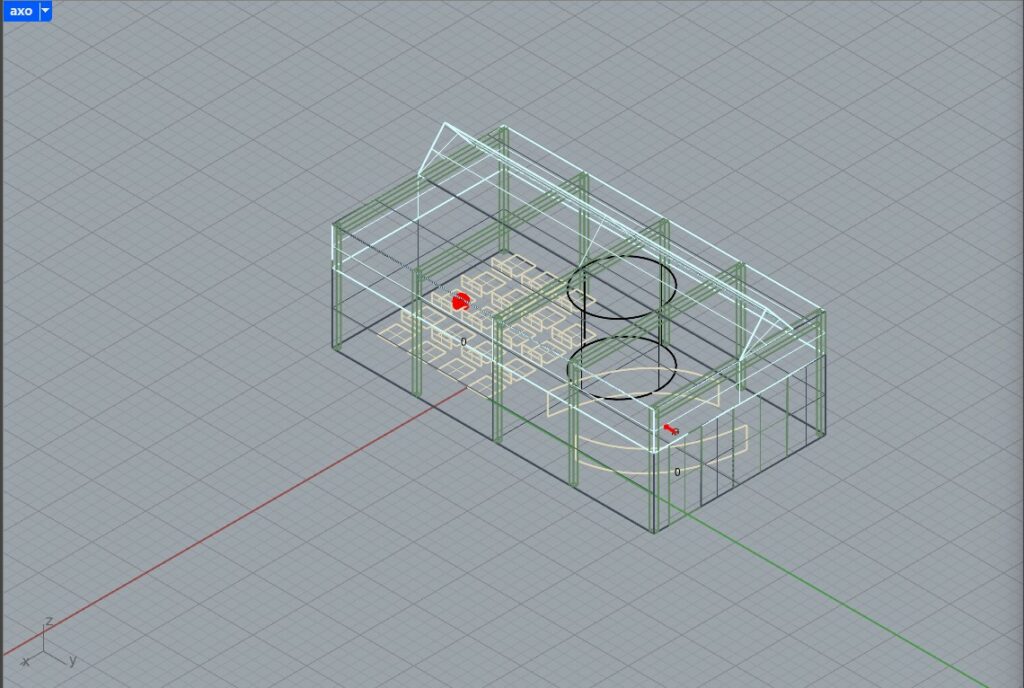
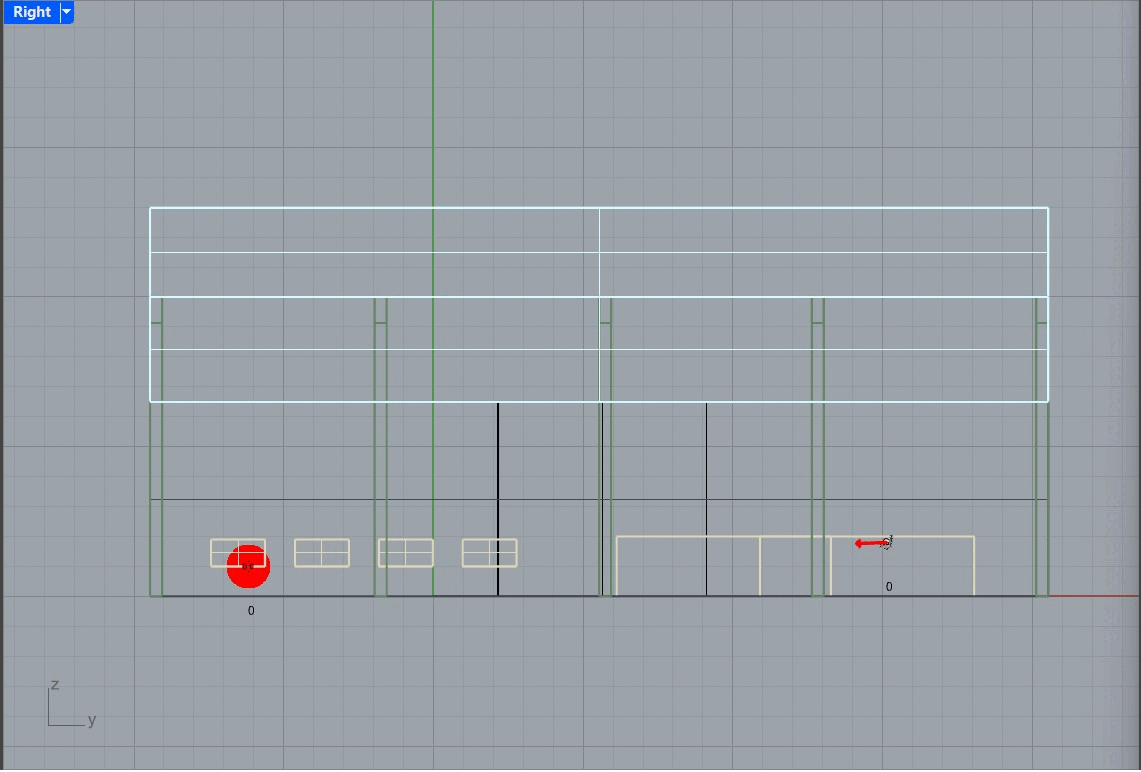
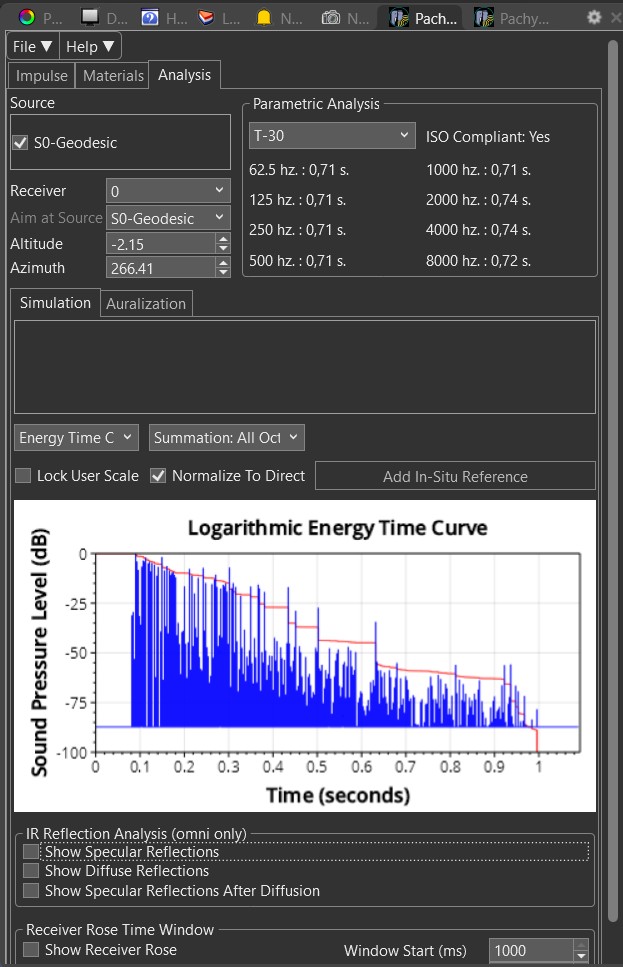
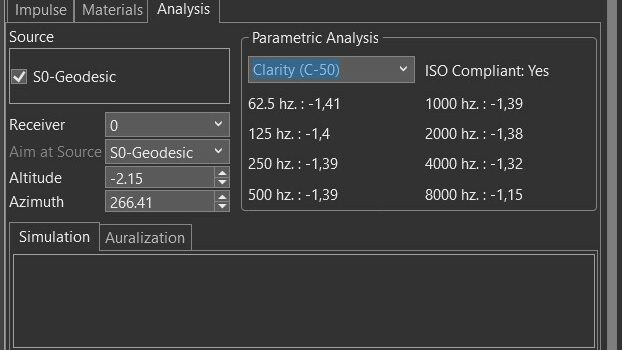
The sound has improved but not enough according to the acoustic comfort guidelines.
3. DIVIDING BLOCK IN THE MIDDLE OF THE SPACE
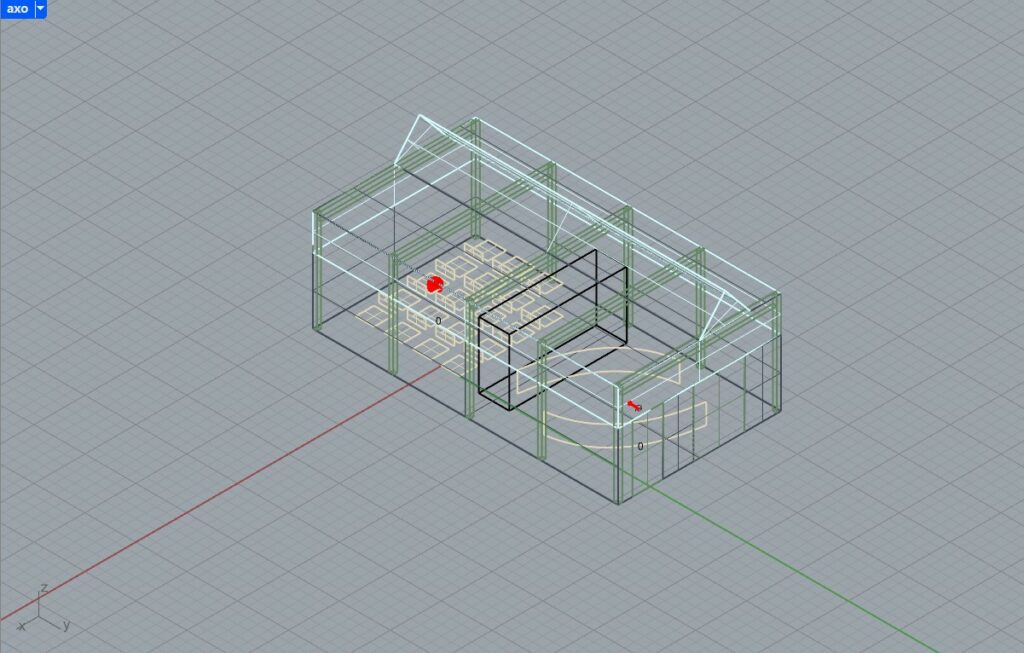
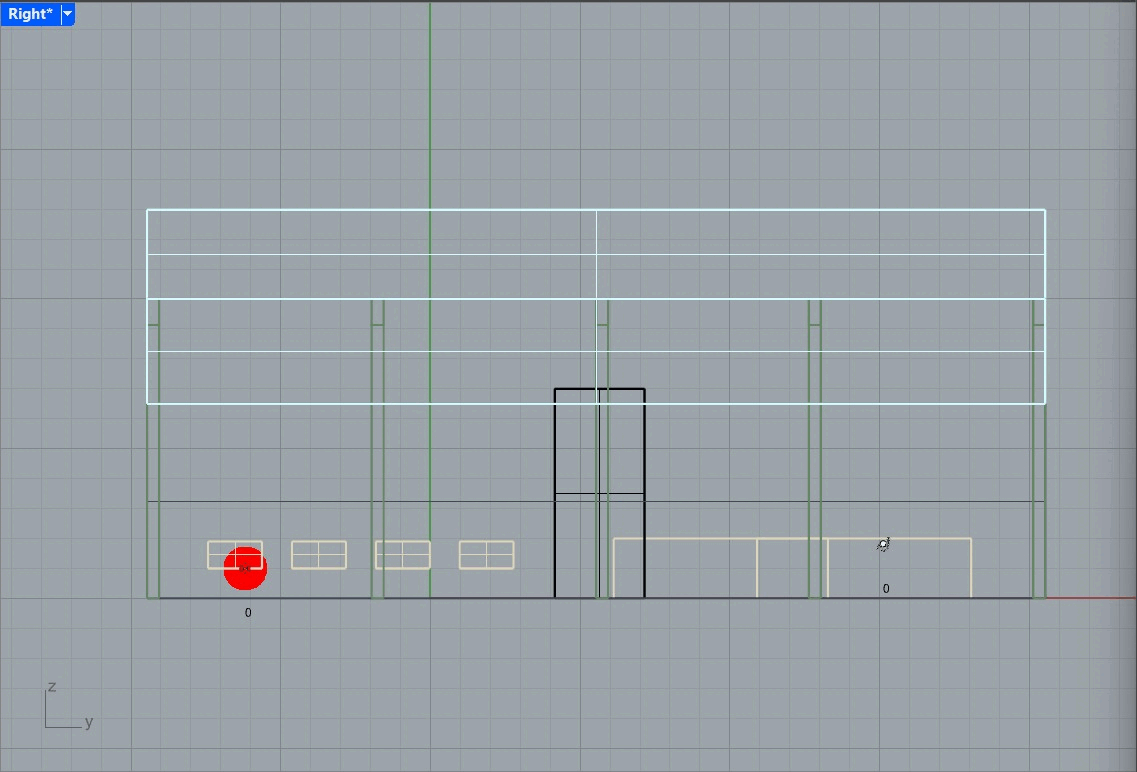
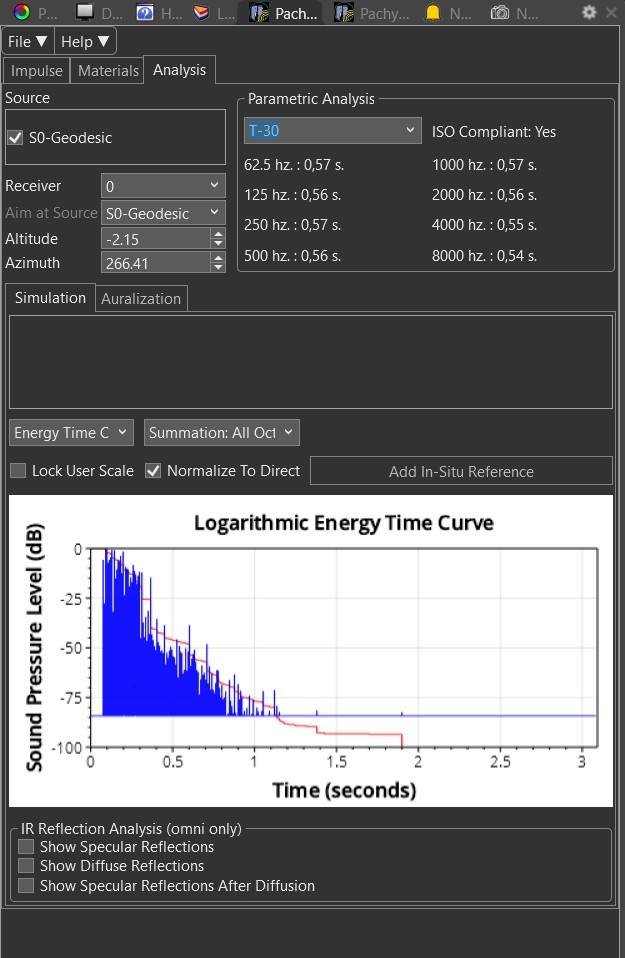

We aim to further divide the space into two main areas. The block acts as a barrier, preventing the most powerful sound particles from crossing to the other side of the room where the receiver is located. In this way, sound does not spread as extensively as in the initial configuration and takes significantly less time to return to the receiver. The negative point of this solution is the loss of a unique big open space
4. DIVIDING BLOCK IN THE MIDDLE OF THE SPACE WITH TILTED ROOF
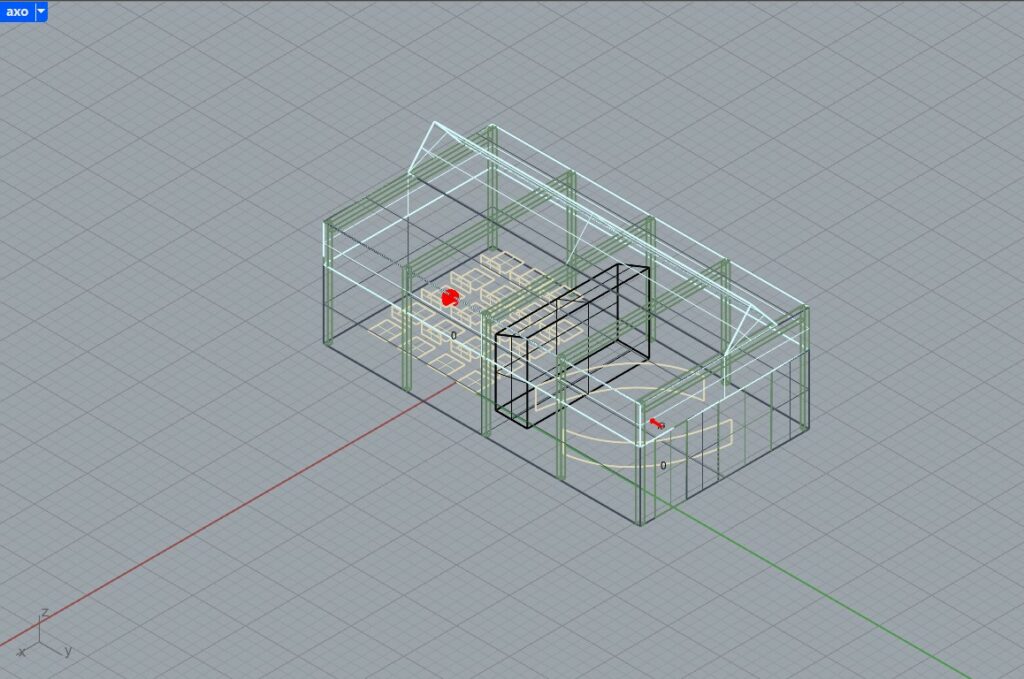

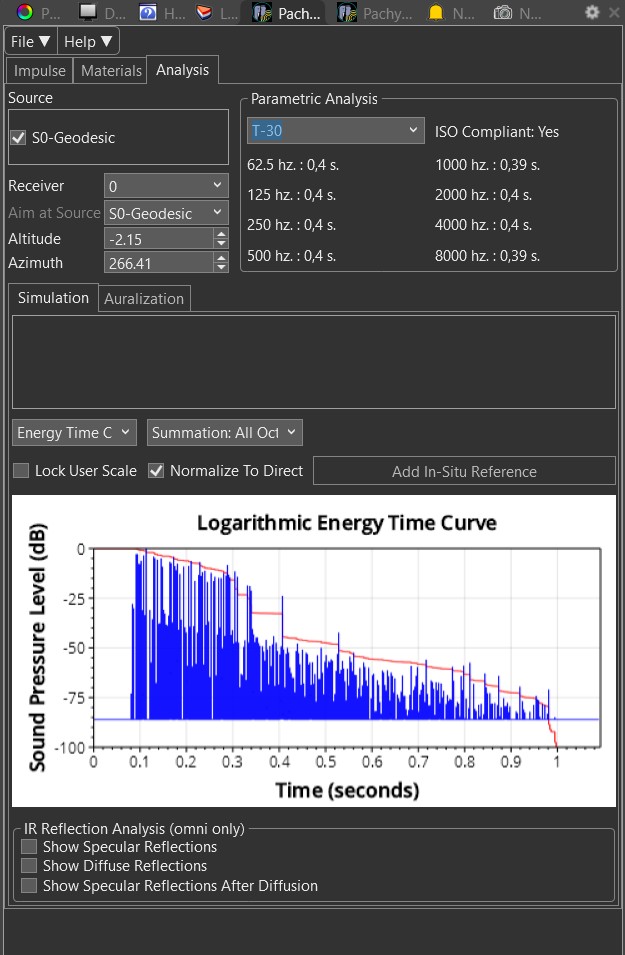
By inclining the roof, we observe an improvement in the acoustic conditions, as the T60 has decreased. The sound particles are guided by the metal beams, which reflect and disperse the sound. The simulation highlights how some of these particles are effectively redirected by the inclined metal beams, reducing their energy and preventing excessive reverberation. This configuration helps control the propagation of sound and improves the overall acoustic performance of the space.
5. BLOCK AGAINT THE WALL

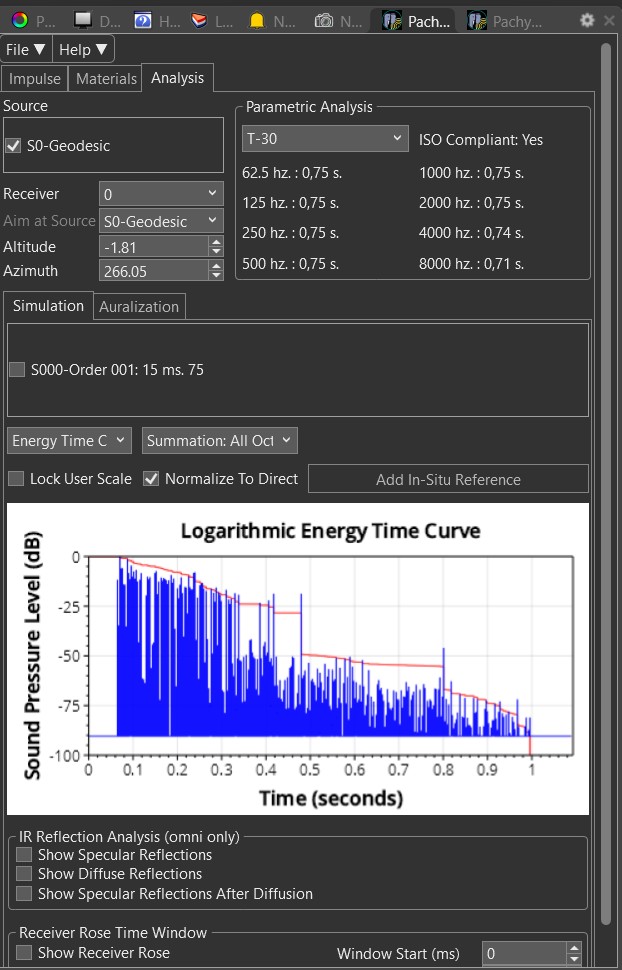
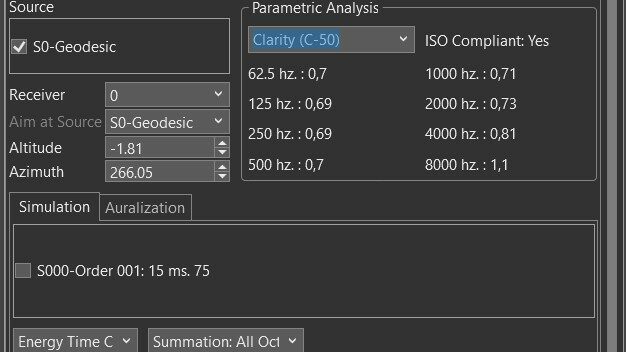
6. DIFFUSERS AS COVERING ELEMENTS




CLARITY TEST
Through a Clarity test, it allows the evaluation of sound clarity in a space by analyzing the ratio between the direct sound (useful) and the reflected sound (reverberation). The scenario is simulated where two people are speaking close to each other. We assist to an improvement of the clarity through the intervention.
Before
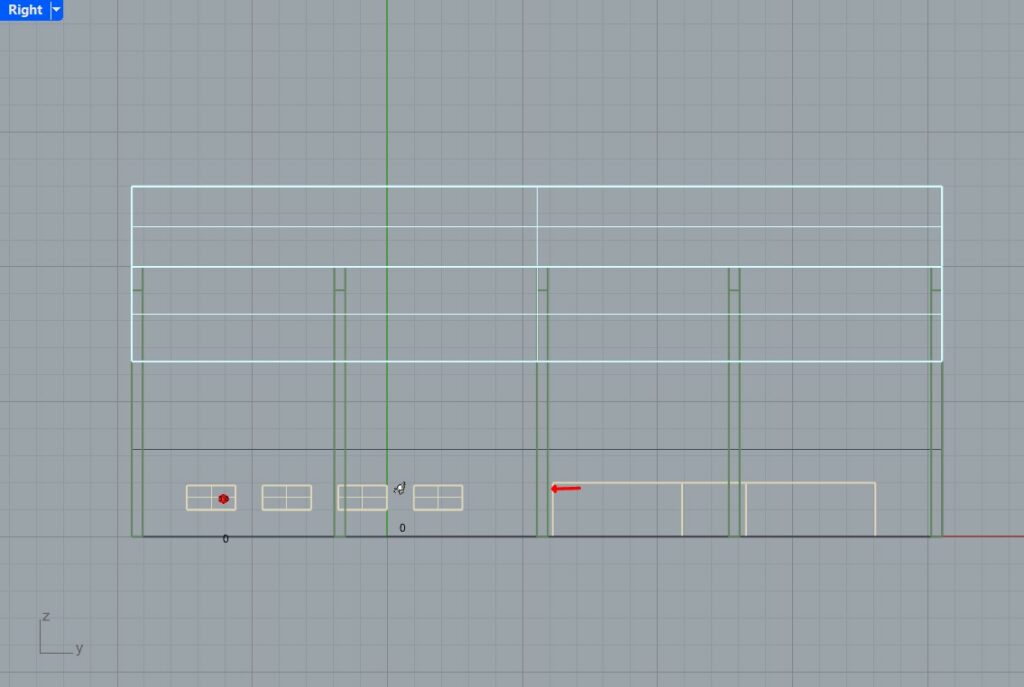
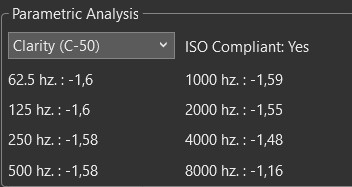
Later


MATERIAL CHOICE
The service block provides an opportunity to install an absorbing surface by cladding its walls. The use of delicate materials such as acoustic foam is excluded, as it could be damaged in such a dusty and rough environment. Instead, wood is proposed as a durable and warm material that contrasts with the metal and concrete, helping to create spaces characterized by calmness and simplicity. This design choice promotes focus and fosters a sense of harmony.
In selecting the materials, the focus is on finding the most performative options in terms of sound absorption. One effective solution is the use of perforated wood panels, which feature a series of holes in varying sizes and arrangements, enhancing acoustic performance. This material can be combined with glass wool, known for its excellent acoustic and thermal insulation properties, ensuring both sound absorption and a comfortable, heated interior space.



